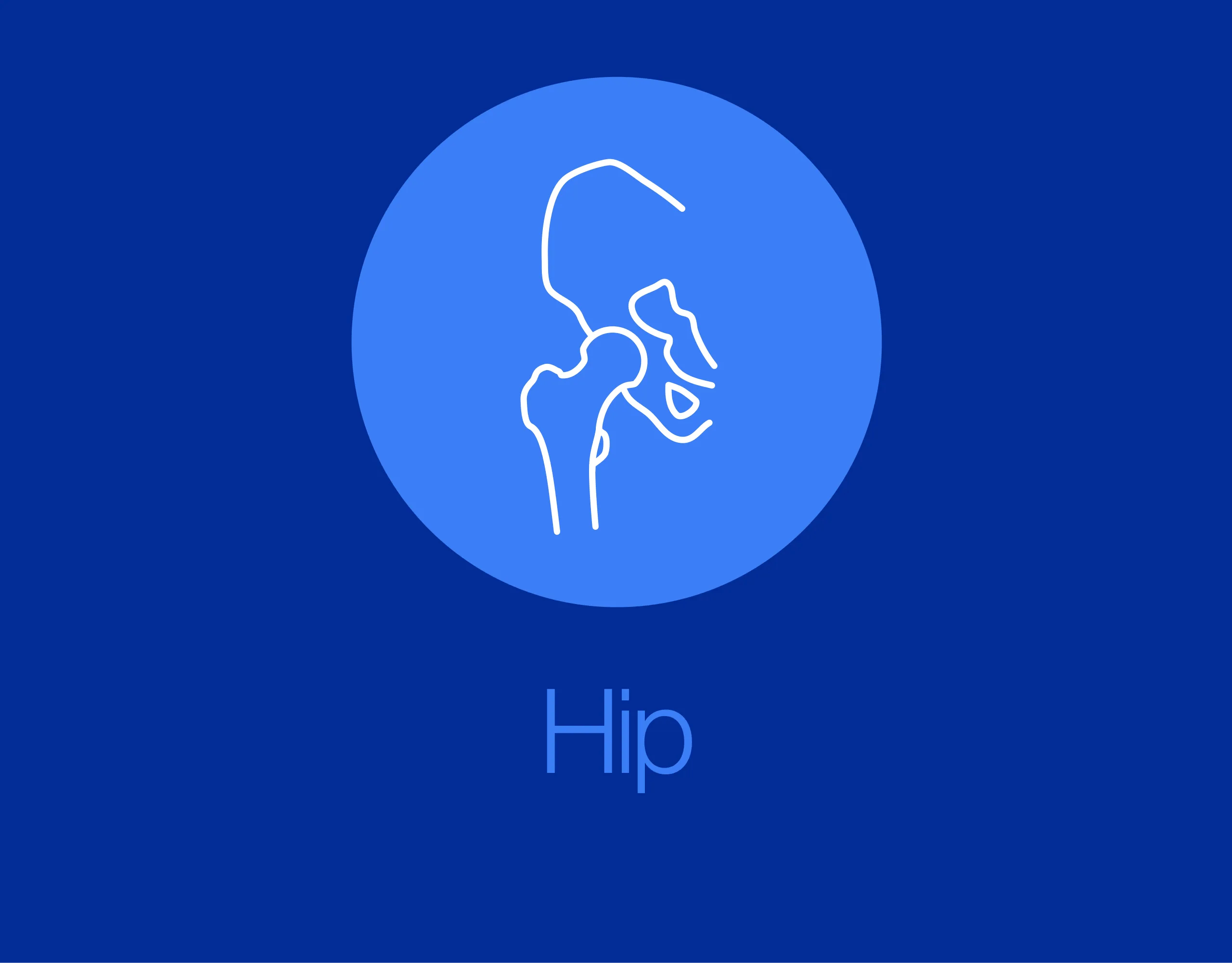ORIF through ilioinguinal approach
1. General considerations
Sequence of the treatment
For ORIF of anterior column fractures with ilioinguinal approach, the following surgical sequence is common :
- Joint distraction and removal of incarcerated fragments
- Reduction of femoral head dislocation if not achieved closed on admission
- Reduction of anterior column
- Assessment of reduction (the anterior column reduction is direct)
- Fixation of the anterior column
Planning/templating
Preoperative templating is essential for understanding the complexity of an acetabular fracture.
When using implants on the innominate bone, it is important to know the best starting points for obtaining optimal screw anchorage (see General stabilization principles and screw directions).
Patient positioning
This procedure is normally performed with the patient in a supine position.
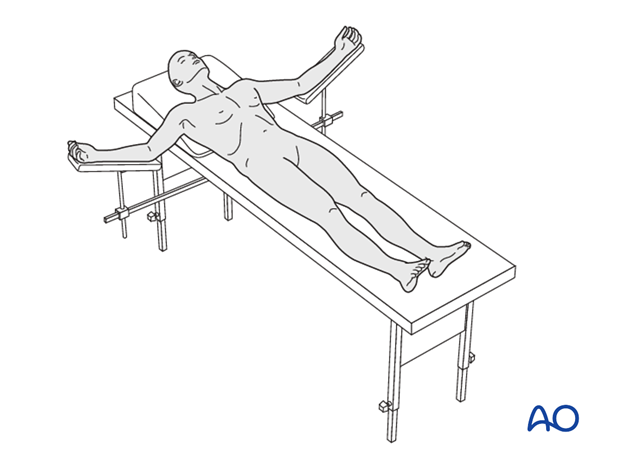
2. Principles of reduction
Reduction from peripheral to central
With the ilioinguinal approach, anterior column fractures are reduced from peripheral to central, starting with the proximal end of the fracture, at the level of the iliac crest (or below), and ending at the acetabular fossa. The peripheral reduction must be anatomical, since displacement there will aggravate malreduction at the acetabular fossa. However, this is surprisingly difficult to achieve and even very small amounts of malreduction at the iliac crest can prevent accurate reduction of the all-important joint.
Indirect visualization
Unusually for a significant joint, articular reduction of acetabular fractures is indirect. The articular surface of the hip joint is not seen directly. Reduction must be assessed by the appearance of the extraarticular fracture lines and intraoperative fluoroscopic assessment. Some fracture lines are palpated manually but not seen directly such as transverse fracture lines on the quadrilateral plate.
Quality of reduction
Posttraumatic arthrosis is directly related to the quality of reduction - the better the reduction, the greater the chance of a good or excellent result.
3. Joint distraction
Application of traction
It is important to ensure hip flexion to allow enhanced exposure of the iliac fossa and true pelvis.
The anterior column fracture is a result of displacement or dislocation of the femoral head at the time of injury. In order to allow manipulation of the anterior column fracture, the femoral head must be distracted. This is typically accomplished with the application of lateral or distal traction.
In some surgeon’s experience, the use of a traction table post or other traction frame is helpful during this operation.
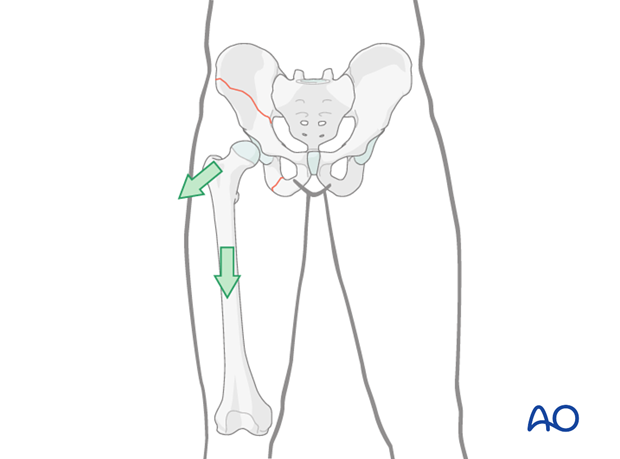
Center the femoral head under the radiological roof using a combination of lateral traction, distal/longitudinal traction, and limb positioning.
Verify the femoral head reduction with the image intensifier.
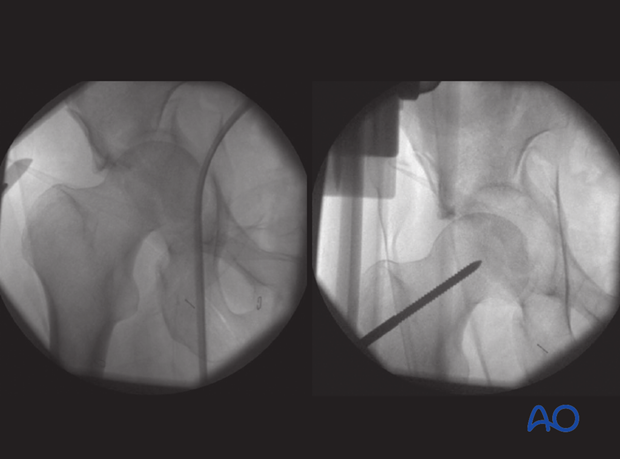
Lateral traction with a trochanter screw
Traction may be applied through a Schanz screw in the greater trochanter, manually or attached to a fracture table.
Insert the screw along the axis of the femoral neck, through a short, separate incision over the greater trochanter.
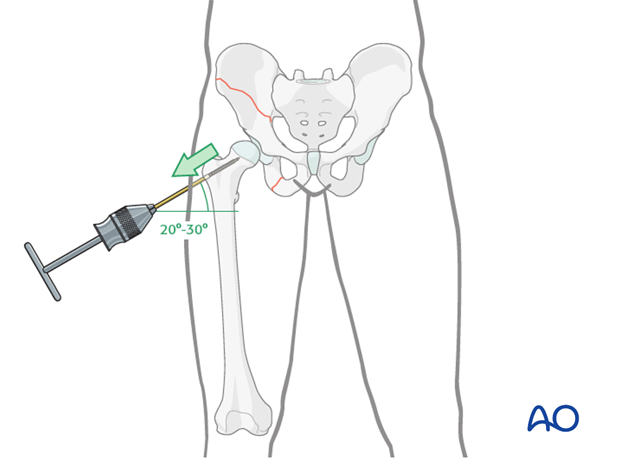
Distal/longitudinal traction
Distal or longitudinal traction may be applied in the axis of the femur. This can be accomplished manually via a distal femoral traction pin or via a fracture table.
Alternatively, a large distractor may be applied using the following technique.
Insert the proximal 5 mm Schanz screw in the sciatic buttress placed from anterior to posterior. This screw must be cranial to the fracture and into an intact segment of the innominate bone. Based on the fracture through the ilium, this screw may not be possible in high anterior column fractures.
Place the distal Schanz screw into the femur at the level of the lesser trochanter from anterior to posterior. Attach the distractor as shown to these two screws.
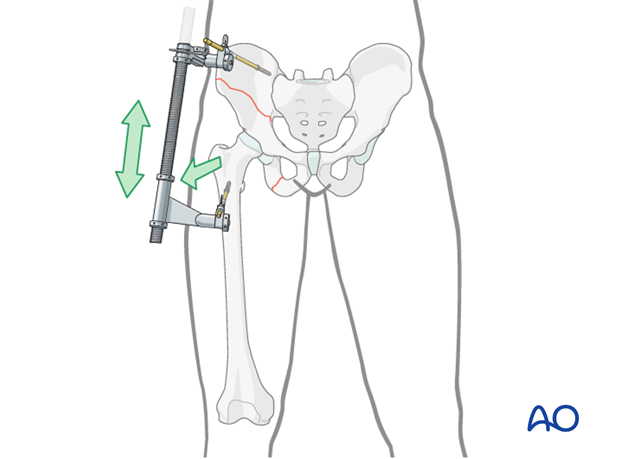
Teaching video
AO teaching video: Use of the distractor on the pelvis
4. Cleaning of the fracture site
Fracture sites are prepared by preliminarily increasing the displacement and then removing early callus and granulation tissue.
Joint distraction is extremely useful to facilitate this debridement.
5. Reduction of marginal impaction
Marginal impaction of the acetabular roof articular cartilage is commonly associated with fractures of the anterior wall or column, particularly in elderly patients.
This marginal impaction must be anatomically reduced and stabilized to optimize outcome.
Unlike fractures of the posterior wall, these areas of impaction cannot be directly visualized. Instead, the reduction of these regions requires fluoroscopic guidance.
On the plain film, one can see the femoral head remains congruent with the displaced anterior wall or column. There is an area of marginal impaction which has been impacted into the intact posterior column. The intact portion of the acetabulum remains in its native location laterally.
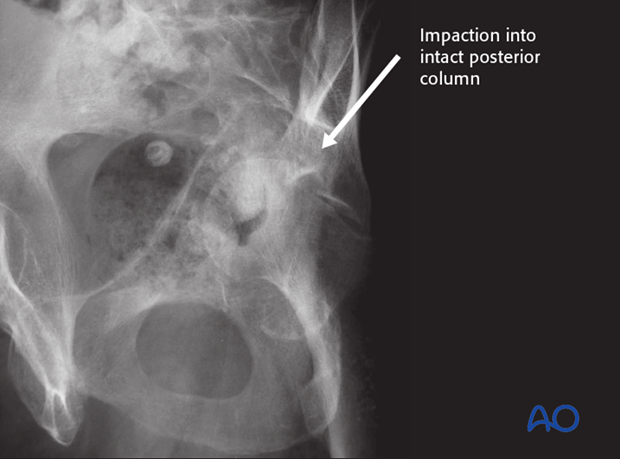
The CT scan demonstrates that the femoral head remains congruent with the anterior wall or column fragment. The quadrilateral surface has hinged around its posterior margin. The area of marginal impaction is seen to be impacted into the posterior column. Importantly, the intact portion of the acetabular roof is seen to cause and impaction injury to the femoral head.
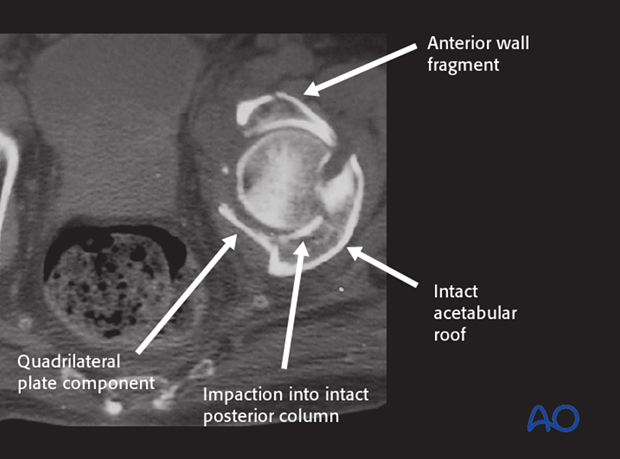
Reduction of this impaction is performed by working through the fracture, or alternatively, through a cortical window created in the ilium.

In either case, the fluoroscopy guides the manipulation and definitive reduction of the impacted segment.
In this example, the osteotome is placed through the fracture.
The area of impaction is mobilized and contoured utilizing the femoral head as a template.
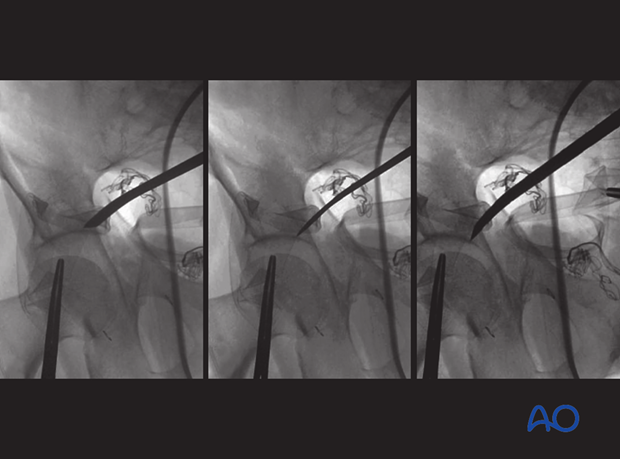
Once the reduced articular surface is in its original position, the defect is filled with cancellous autograft or a bone substitute.
After articular impaction has been addressed, one can proceed with fracture reduction.
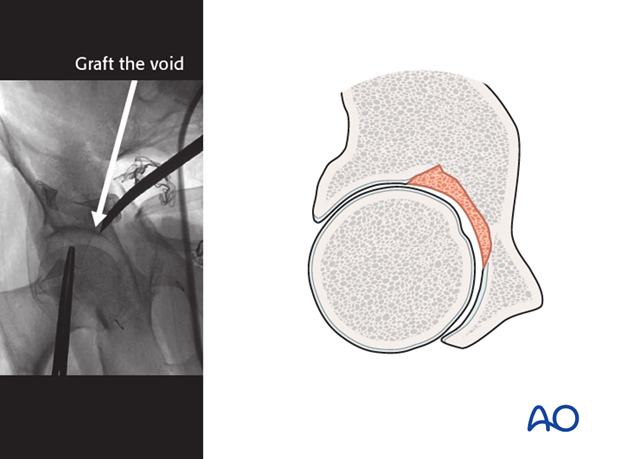
6. Reduction and preliminary fixation
Principles
Reduction proceeds from cranial to caudal, and is eased with hip flexion to relax the pull of the rectus femoris. First reduce the peripheral end of the fracture (iliac crest).
Manipulation of the iliac region
Manipulation of the iliac region of the fragment is achieved with the help of a Farabeuf clamp, pointed reduction forceps, a Schanz screw, and/or one or more of the specialty pelvic clamps.
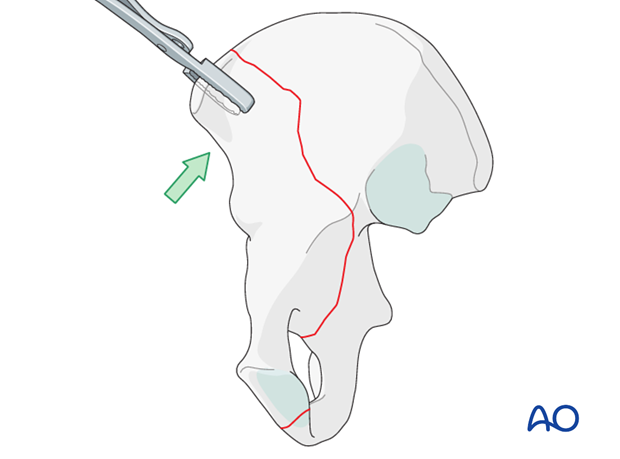
Reduction of the pelvic brim
A ball spike pusher is very helpful in restoring the concavity of the ilium. While the Farabeuf controls the superficial ilium, a ball spike pusher applied just above the pelvic brim with a lateralizing force allows the fragment to abduct and rotate.
The pelvic brim should be reduced to match the brim of the intact segment.
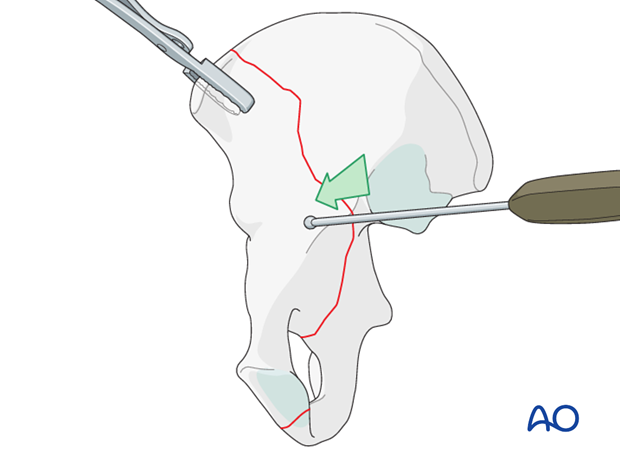
Further clamps
Another clamp is placed between the reduced pelvic brim fragment and the external surface of the bone just lateral to the anterior inferior iliac spine.
Depending upon fracture configuration, additional clamps may be useful.
The fracture along the quadrilateral surface will demonstrate the quality of the reduction between the anterior and posterior column.
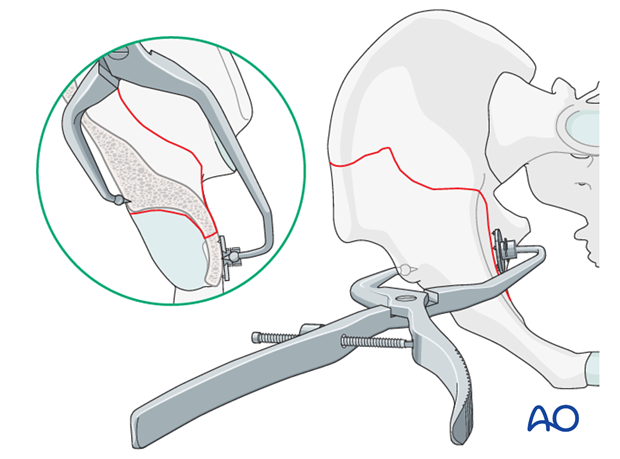
Preliminary fixation
Preliminary fixation of the iliac crest and cranial fracture is provided by pointed reduction forceps across the reduced fracture at the iliac crest.
Preliminary intramedullary K-wires may be applied along the iliac crest and the iliac corridor as additional fixation.
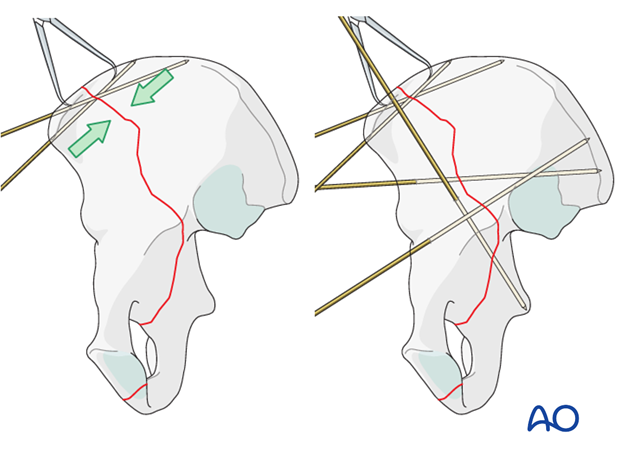
7. Definitive fixation
Lag screw osteosynthesis
For fixation of the upper part of the anterior column fracture, lag screw osteosynthesis is preferable. At the iliac crest use small fragment screws (long 3.5 mm). At the level of the pelvic brim, larger screws may be used (see considerations for safe screw placement).

Additional lag screws
At the pelvic brim segment, one or two additional isolated interfragmentary lag screws can be applied from the anterior into the posterior column (see considerations for safe screw placement).
Isolated lag screw placement may not provide adequate fracture stability, and plate osteosynthesis may be required.
Position lag screws so they do not interfere with optimal plate location.
Make sure to insert every screw extraarticularly.

High anterior column fractures (A) involve large areas of extraarticular bone allowing many opportunities for interfragmentary screw placement.
Stable fixation becomes more difficult as the cranial extent of the fracture is more distal.
With intermediate (B) and low anterior column (C) fractures, there is less extraarticular bone available for interfragmentary screws. With very low fractures (like anterior wall fractures), it may not be possible to place interfragmentary screws without violating the articular surface.
When placing interfragmentary screws close to the acetabulum, great care must be taken to avoid articular perforation.
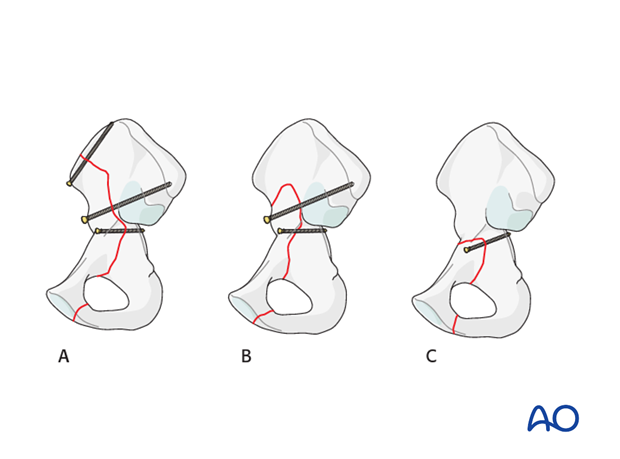
Plate fixation of iliac crest
If intramedullary screws cannot be obtained along the iliac crest secondary to comminution or osteoporosis, a plate across the fracture can be utilized. The screws for an iliac crest plate are typically 12-16 mm long, and thus offer limited purchase.
A plate across the fracture line at the iliac crest can also be used to supplement lag screw fixation at this level.
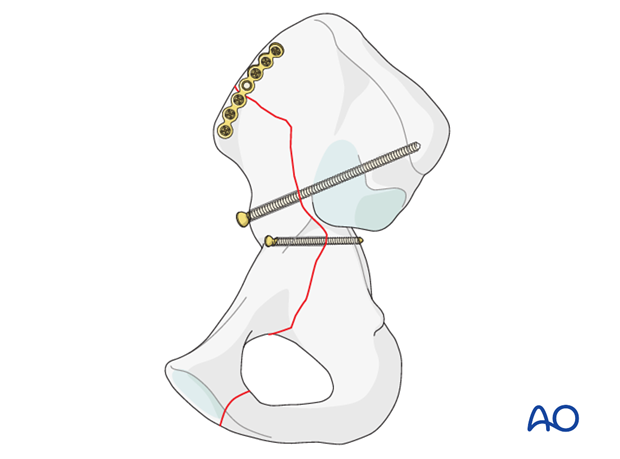
Pelvic brim neutralization plate
Neutralize the reduced fracture with a pre-contoured small fragment pelvic reconstruction plate applied to fit the reduced fracture.
The plate bridges the reduced pelvic brim segment of the anterior column. Cranially, it extends to ensure at least two screws into the intact sciatic buttress. It is positioned in the medial iliac fossa adjacent to the SI joint. The cranial screws are placed anterior to posterior parallel to the SI joint, and typically measure 40-60 mm in length.
Care should be taken to avoid inadvertent violation of the SI joint.
In the mid portion, interfragmentary screws can be applied through the plate. Care should be taken to ensure that each screw is placed extraarticularly, as this region is juxtaarticular.
Inferiorly, the plate can be secured to the pubic ramus and the body of the pubis. Distal fixation becomes increasingly important in lower fractures, in which there are limited superior/cranial fixation opportunities.
Note
In case of osteoporotic bone adequate anchorage of the neutralization plate is only obtained by the use of very long screws near the SI joint and the symphysis pubis. Typically, more screws are required in osteoporotic bone.
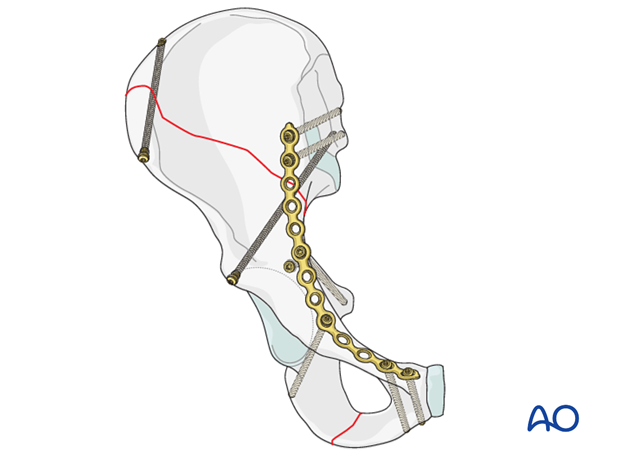
8. Radiographic assessment
Assessment of screw trajectory
The position of all screws should be assessed, particularly those close to the acetabulum. An image centered over a screw and aimed along its axis is the best way to ensure that it does not enter the hip joint.
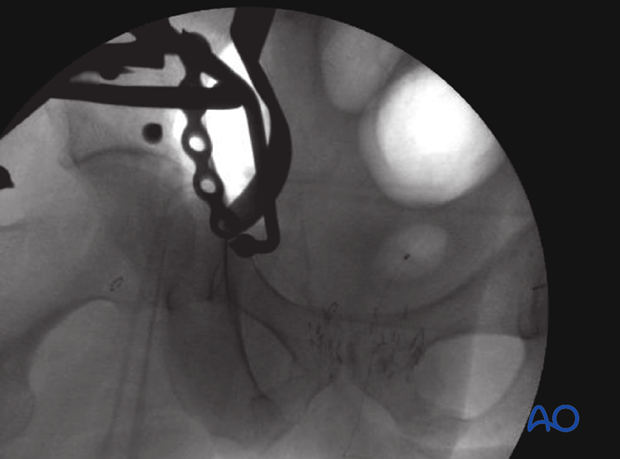
Clinical example
This example demonstrates a high anterior column fracture.
Note the cranial fracture extension through the iliac crest (thus characterized as a “high” fracture).
The integrity of the ilioischial line indicates an elementary anterior column fracture. The CT scan would be evaluated for a nondisplaced fracture violating the retroacetabular surface to ensure the fracture is an elementary anterior column fracture and not an anterior column/posterior hemitransverse fracture.
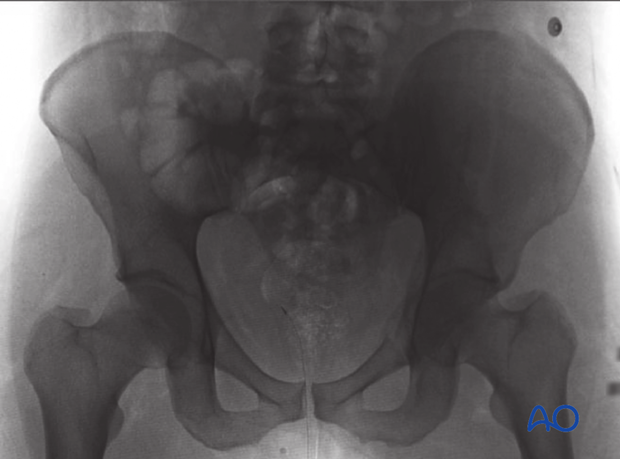
The final AP, obturator oblique and iliac oblique radiographs demonstrate:
- An anatomic reduction indicated by the lack of displacement at the fracture line at the iliac crest. A secondary indicator is the lack of displacement of the caudal fracture through the obturator foramen.
- Lag screw fixation of the upper part of the anterior column fragment at the iliac crest and at the level of the pelvic brim.
- An additional fragmentary lag screw applied from the displaced anterior column into the posterior column.
- A plate spanning the displaced fragment with fixation cranially into the sciatic buttress.
- In the mid portion interfragmentary screws have been applied through the plate into the column.
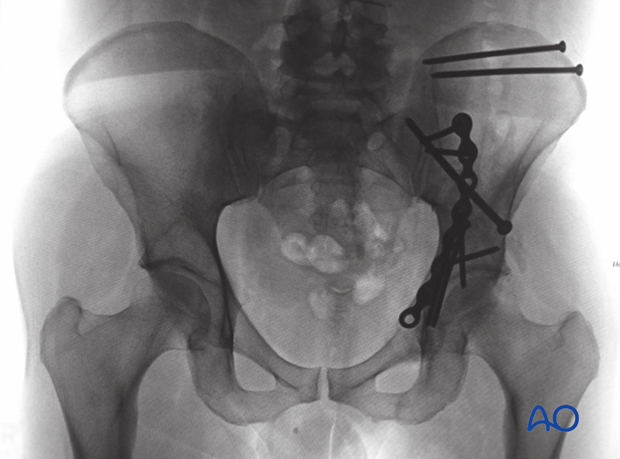
- The iliac oblique (A) demonstrates the posterior column screw position with respect to the sciatic notch and also shows that they are extraarticular.
- The obturator oblique (B) demonstrates the anatomical reduction of the articular surface and also the extraarticular nature of the supraacetabular screw.
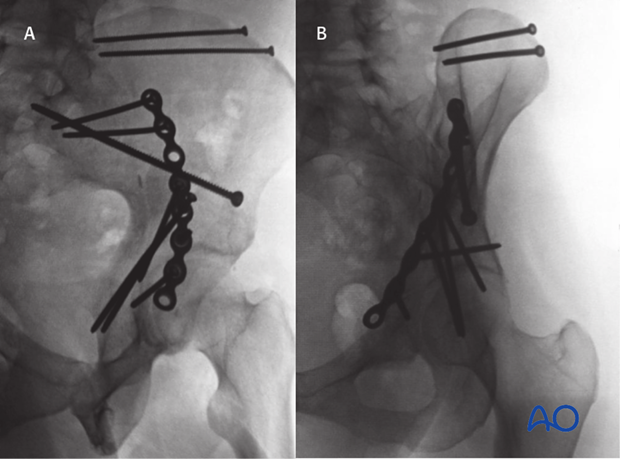
9. Wound closure
Before closure, one may place drains in the space of Retzius and anterior internal iliac fossa.
Layered closure then begins with repair of the conjoint tendon to the distal inguinal ligament. A careful fascial repair restores the floor of the inguinal canal.
The external oblique aponeurosis and the rectus sheath are then repaired, followed by secure reattachment of the abdominal wall origin to the iliac crest, in the lateral portion of the incision. A hernia-free repair, and avoidance of entrapment of the spermatic cord should be achieved.
Subcutaneous drains may be inserted.
Finally, perform an appropriate subcutaneous and skin closure.
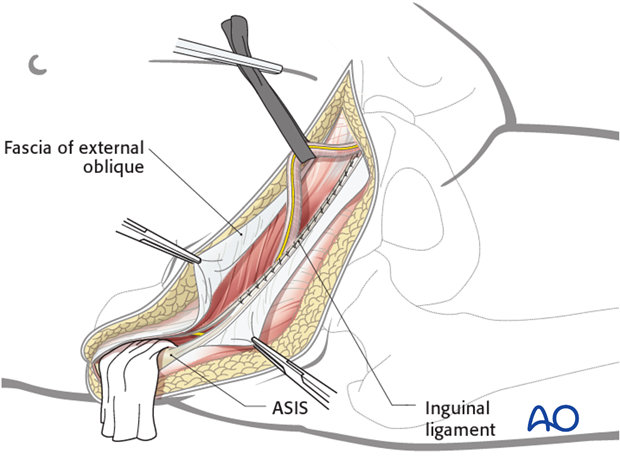
10. Postoperative care
During the first 24-48 hours, antibiotics are administered intravenously, according to hospital prophylaxis protocol. In order to avoid heterotopic ossification in high-risk patients, the use of indomethacin or single low dose radiation should be considered. Every patient needs DVT treatment. There is no universal protocol, but 6 weeks of anticoagulation is a common strategy.
Wound drains are rarely used. Local protocols should be followed if used, aiming to remove the drain as soon as possible and balancing output with infection risk.
Specialized therapy input is essential.
Follow up
X-rays are taken for immediate postoperative control, and at 8 weeks prior to full weight bearing.
Postoperative CT scans are used routinely in some units, and only obtained if there are concerns regarding the quality of reduction or intraarticular hardware in others.
With satisfactory healing, sutures are removed around 10-14 days after surgery.
Mobilization
Early mobilization should be stressed and patients encouraged to sit up within the first 24-48 hours following surgery.
Mobilization touch weight bearing for 8 weeks is advised.
Weight bearing
The patient should remain on crutches touch weight bearing (up to 20 kg) for 8 weeks. This is preferable to complete non-weight bearing because forces across the hip joint are higher when the leg is held off the floor. Weight bearing can be progressively increased to full weight after 8 weeks.
With osteoporotic bone or comminuted fractures, delay until 12 weeks may be considered.
Implant removal
Generally, implants are left in situ indefinitely. For acute infections with stable fixation, implants should usually be retained until the fracture is healed. Typically, by then a treated acute infection has become quiescent. Should it recur, hardware removal may help prevent further recurrences. Remember that a recurrent infection may involve the hip joint, which must be assessed in such patients with arthrocentesis. For patients with a history of wound infection who become candidates for total hip replacement, a two-stage reconstruction may be appropriate.
Sciatic nerve palsy
Posterior hip dislocation associated with posterior wall, posterior column, transverse, and T-shaped fractures can be associated with sciatic nerve palsy. At the time of surgical exploration, it is very rare to find a completely disrupted nerve and there are no treatment options beyond fracture reduction, hip stabilization and hemostasis. Neurologic recovery may take up to 2 years. Peroneal division involvement is more common than tibial. Sensory recovery precedes motor recovery and it is not unusual to see clinical improvement in the setting of grossly abnormal electrodiagnostic findings.
